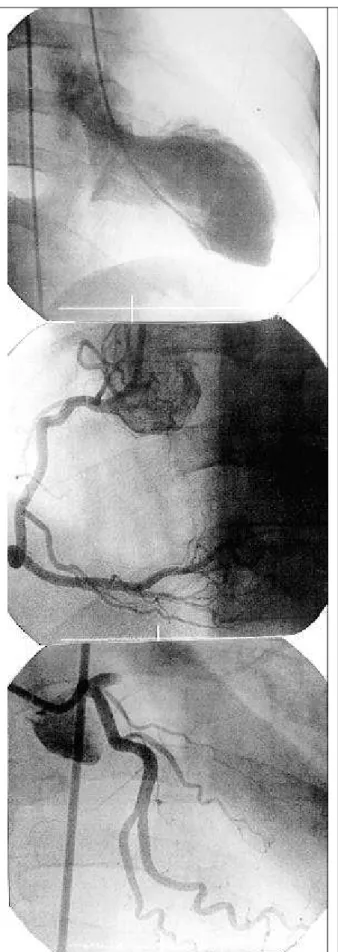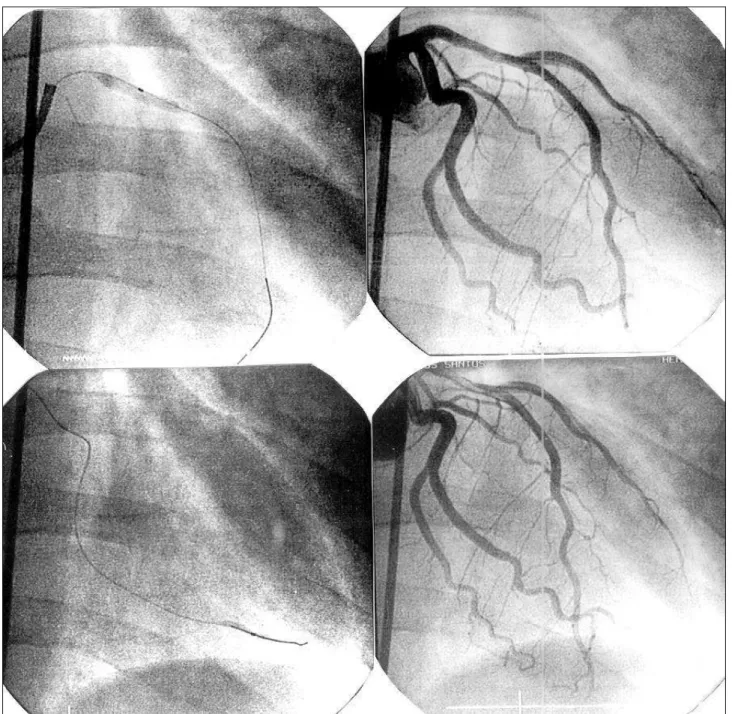100
Arq Bras Cardiol volume 73, (nº 1), 1999 Essential thrombocythemia and rescue angioplasty
Instituto do Coração do Hospital das Clínicas – FMUSP
Mailing Address: Antonio Esteves Fº - Incor – Serviço de Hemodinâmica – Av. Dr. Enéas C. Aguiar, 44 – 05403-000 – São Paulo, SP
Antonio Esteves Fº, Francisco de Assis Costa, Antonio Augusto Guimarães Lima, LuizJunya Kajita, Eulógio Emílio Martinez Fº
São Paulo, SP - Brazil
Essential Thrombocythemia and Acute Myocardial Infarction
Treated with Rescue Coronary Angioplasty
Case Report
A 48-year-old man with essential thrombocythemia suffered an extensive anterior acute myocardial infarc-tion; this is a rare association. A pharmacological throm-bolysis was performed, without success. He subsequently underwent successful rescue coronary angioplasty. To our knowledge, there is no other report in the literature relating the triad of essential thrombocythemia, acute myocardial infarction and rescue coronary angioplasty.
Essential thrombocythemia (ET) is a primary myelo-proliferative disorder in which the platelet count becomes elevated. The predominant clinical manifestations of ET result from hemorrhagic or thromboembolic complications 1. Factors related to vascular dynamics, such as vanishing platelet thrombi, are likely to play an important role in the genesis of myocardial ischemia and infarction, events rarely found in individuals with ET 2,3. In this study, a case of ante-rior acute myocardial infarction (AMI) diagnosed in a patient with known ET is reported. The patient received thrombolytic therapy, followed by successful rescue coronary angioplasty (RCA).
Case Report
A 48-year-old white male patient arrived at the Emer-gency Department (ED) of the Instituto do Coração (INCOR) complaining of chest pain consistent with coro-nary artery disease, which had started 3h before arrival at the ED. At the time of hospital admission, the physical examination showed no abnormal findings, with the exception of high blood pressure (180/120mmHg). The electrocardiogram showed an elevation of the ST segment in leads D1, aVL, and from V1 to V6, consistent with extensive anterior AMI. Intravenous streptokinase was started with a 3h delay (representing the time interval between the development of the symptoms and the beginning of the infusion). There were no clinical criteria for myocardial reper-fusion and the patient was classified as group II of the
Killip-Kimball heart failure classification. Thus, RCA was started 9h after the beginning of the symptoms. The coro-nary angiography, performed according to the Judkins tech-nique, showed an occlusion of the proximal third of the left anterior descending coronary artery (LAD), without any evidence of atherosclerotic lesions in the remaining arteries (fig. 1). The RCA (balloon) of the LDA was successfully performed. The control angiography showed occlusion of the distal portion of the 2nd marginal branch of the left cir-cumflex artery (M2), as a result of the migration of a throm-bus. This vessel was also dilated, with a successful out-come (fig. 2).
There were no incidents during hospitalization. CK-MB peaked at 244 U/l (normal range, up to 10 U/l) and the echocardiography performed 3 days after the coronary event showed a value of 59% for the ejection fraction of the left ventricle, septal hypokinesis, and akinesis of the apical wall.
The patient reported high blood pressure for appro-ximately the previous 20 years and use of amlodipine on an irregular basis. He denied other risk factors for coronary artery disease and reported that, 3 months before, he had suffered from self-limited chest pain with similar charac-teristics, pain of short duration unrelated to physical or emotional stress. The patient knew he suffered from ET 4 years earlier, when he was diagnosed with it by an expert, based on laboratory findings (platelet count, peripheral blood smear, and platelet aggregation tests) and confirmed by myelogram. He was not in use of any specific medication for ET. The platelet count was 1,100,000/mm3, without other significant abnormalities in white blood cell or red blood cell counts. The protein electrophoresis, the urine analysis, the chest films and the abdominal ultrasonography did not show any significant abnormalities. The patient was discharged on the 16th day of hospitalization and was prescribed acetylsalicylic acid, nitrate, beta-blocker, angiotensin-converting enzyme inhibitor and hydroxyurea, 1,500mg/d.
Discussion
Arq Bras Cardiol volume 73, (nº 1), 1999
101
Essential thrombocythemia and rescue angioplasty
to 21% 4. This disorder may lead to the formation of thrombi and acute arterial occlusion, as well as hemorrhagic complications, probably as a result of platelet dysfunction. In both manifestations of the disease, a reduction of platelet aggregation, mainly with adrenaline, is frequently noted 1. However, when platelet antiaggregating agents are used, as occurred in the present case, these tests lack diagnostic utility. Although rare, sudden death and AMI are compli-cations described in hematologic diseases, such as myelo-proliferative disorders characterized by significant changes in the platelet count 3. When the platelet count exceeds 600,000/mm3, ET may cause coronary thrombosis in diffe-rent arteries 5. Possible explanations for this phenomenon include: 1) platelet activation as a result of endothelial injury; 2) prolonged arterial spasm with subsequent throm-bosis; 3) increased activity of the platelets; 4) changes in the glycoprotein of the platelet granulesin patients with ET; and 5) possible selective deficiency of lipoxygenase in individuals with myeloproliferative disorders 5. In a study involving 55 patients with ET, secondary thrombocytosis, polycythemia vera, chronic granulocyticleukemia, agno-genicmyeloidmetaplasiaandmyelodysplasticsyndrome, Raman et al 6 performed, in 43 of these patients, a series of tests to evaluate the hematological profile. These tests in-cluded thorough analysis of platelet aggregation, from platelet factor IV, von Willebrand factor and ultrastructural study, to electronic microscopy and bone marrow biopsy. The latter showed that all the patients suffering from ET, polycythemia vera and chronic granulocyticleukemia had a moderate to significant increase of the reticular fibers. It was concluded that 62% of all patients showed abnormal results to one or more of the inducers employed in the platelet aggregation tests. It was also concluded that different responses in the aggregation tests, levels of platelet factor IV, b-thromboglobulin, factor VIII and fibrinogen, are useful in distinguishing ET from secondary thrombocytosis. Scheffer et al 4, reported a series of 7 patients, 6 with ET and one with polycythemia vera; two of them suffered AMI and 5 unstable angina. All the patients under 50 years of age showed normal coronary arteries or one-vessel disease. In this same series, the authors successfully controlled the thrombotic events during 1 to 6 years with the use of aspirin orbusulfan, suggesting the ineffectiveness of the therapy with warfarin. The use of hydroxyurea, 500 to 1,500mg/d, is supported by the literature. These findings are in accor-dance with the results of the present study in which there were no concurrent atherosclerotic lesions. The absence of spleen enlargement in a patient who did not receive specific therapy for ET, a finding that is quite infrequent, is also of note. On the other hand, considering the fact that the pa-tient was a hypertensive male, almost reaching the 6th decade of life, one must not rule out that the atherosclerotic coro-nary disease could account for the acute event. However, the apparently healthy condition of the remaining coronary arteries leads one to the assumption that the infarction could have occurred as a primary result of the coagulopathy. To our knowledge, there is no other report in the literature of the triadET, AMI and RCA.
102
Arq Bras Cardiol volume 73, (nº 1), 1999 Essential thrombocythemia and rescue angioplasty
1. Pick RA, Glover UM, Nanfro JJ, Dubbs WF, Gibbons JA, Vieweg WVR. Acute myocardial infarction with essencial thrombocythemia in a young man. Am Heart J 1983; 106: 406-7.
2. Heggtviet HA. Coronary thrombosis and myocardial infarction. J Am Coll Cardiol 1983; 2:785.
3. Rumoroso JR, Montes PM, Jiménez A, et al. Trombocitosis y enfermedad coronaria. A propósito de un caso. Rev Esp Cardiol 1996; 49: 542-4.
References
4. Scheffer MG, Michiels JJ, Simoons ML, Roelandt JRTC. Thrombocythemia and coronary artery disease. Am Heart J 1991; 122: 573-6.
5. Douste-Blazy P, Taudou MJ, Delay, et al. Essential thrombocythaemia and recurrent myocardial infarction. Lancet 1984; 2: 992.

